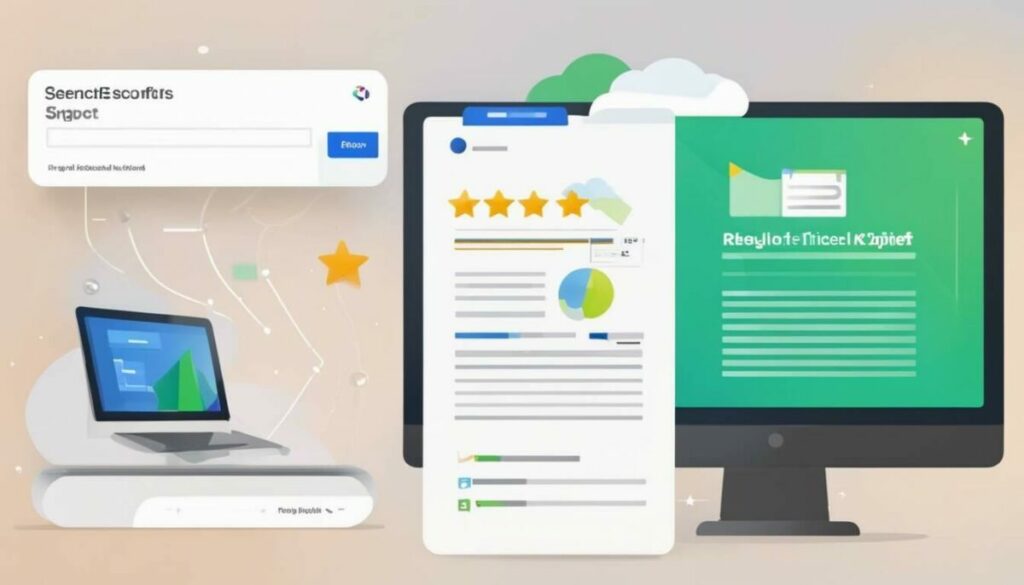Google shakes up its search algorithm with core updates several times in a year. These updates, larger ones might be spaced out by several months, are designed to refine and perfect how Google’s systems assess content. Contrary to traditional belief, Google‘s recent focus isn’t solely on keywords; it is prioritizing relevance and quality of content that matches user intent. So, if you’re under the impression that keyword stuffing will achieve top rankings, you may have to reevaluate your strategy. You’ll learn more about this shift as we proceed.
Google releases Core updates several times a year, implementing broad changes to its search algorithms and systems. These updates aim to enhance the assessment of content overall, providing helpful and reliable results for searchers.

Recent Trends in Google Core Updates
Google has been making significant changes to its core updates, emphasizing qualities beyond simple keyword stuffing. The focus now lies on intent-based content, meaning that search results are more closely aligned with what users actually want when they type a query into the search bar. In essence, Google aims to refine search results, ensuring users find the most relevant and high-quality content based on their search intent.
It’s crucial to recognize that this shift toward intent-based content has altered the landscape of search engine optimization (SEO) practices. Previously, website ranking heavily relied on the strategic placement of keywords throughout the content. However, with this shift in focus, experts now emphasize the importance of delivering valuable, detailed information that directly addresses user needs and queries. For website owners and creators, this transition underscores the necessity of crafting content that genuinely meets audience needs rather than solely targeting specific keywords for ranking purposes.
One notable impact of this change is the decline in the effectiveness of outdated SEO tactics built around keyword density manipulation. Instead, websites are encouraged to align with Google’s emphasis on user satisfaction and overall experience by prioritizing high-quality and informative content. This means creating material directly tailored to address user inquiries and needs while demonstrating authority and expertise within the topic.
According to a report published by Moz in 2023, 64% of marketing professionals consider creating rich and relevant content as the most effective SEO tactic. This highlights the industry’s recognition of Google’s updated priorities and indicates a substantial shift in SEO strategies.
This evolution marks a fundamental leap in how websites are perceived by search engines. It’s no longer just about having a website filled with keywords but about presenting quality content that truly resonates with users’ searches. This forces site owners to reevaluate their approach and invest in crafting comprehensive, insightful pieces that thoroughly address users’ queries.
Understanding these shifts in Google’s core update criteria provides crucial insight into how website owners should approach their content creation strategy to maintain or improve their visibility in search results.
As we continue our exploration of Google’s core updates, let’s delve deeper into the frequency with which these substantial alterations occur.
Unveiling the Frequency of Core Updates

Google’s search algorithm is often compared to a living organism, constantly evolving and adapting. It’s no surprise then that they make an average of nine changes per day to their algorithm, equivalent to over 3,200 changes in a year. While these changes can be minor and go unnoticed by many, they play a crucial role in shaping the search landscape. However, when we talk about core updates, they are more substantial than daily tweaks and often have a more noticeable impact.
These broad core updates are pivotal moments for websites. They occur several times a year and can have a profound impact on the ranking of websites across different niches. The timeline between major core updates can vary, with some taking place over several months and others being released in quick succession. Such unpredictability keeps website owners on their toes as they try to adapt to the changes in search rankings.
To put this into context, let’s consider the impact of the recent March 2024 Core Algorithm Update and the March 2024 Spam Update. The core update aims at improving the quality of search results, while the spam update targets specific issues such as expired domain abuse, scaled content abuse, and site reputation abuse.
An understanding of the frequency and timing of these core updates is essential for website owners and digital marketers alike. It allows them to anticipate when significant shifts in search rankings might occur and prepare accordingly. Marketers must stay updated on these algorithm changes to optimize their websites for the latest search engine requirements and maintain visibility.
It’s like knowing when big waves are coming at the beach – if you know when they’re about to hit, you can brace yourself and adjust your position to avoid getting swept away!
Now that we’ve unraveled the frequency and significance of core updates, let’s dive deeper into their impact on website rankings.
Decoding the Algorithm Changes

The enigmatic realm of Google algorithm changes can feel like attempting to decipher a cryptic code. Understanding the implications of these changes on website ranking is vital for digital marketers and website owners. Over time, it’s been observed that Google places a strong emphasis on quality and relevance in its algorithm updates. This means that websites producing high-quality, authoritative, and informative content are more likely to be rewarded with higher rankings.
Expanding on this idea, these changes aren’t just about keywords and links; they’re about creating a positive experience for users. Google has gradually shifted its focus towards user experience and engagement metrics. This shift indicates a more people-oriented algorithm, where interactions with the website, such as time spent on page, bounce rate, and click-through rates, play a significant role in determining the overall ranking of a website.
For instance, if users tend to quickly leave a website after landing on it, this high bounce rate signals to Google that the page may not be relevant or useful. Conversely, if users spend a significant amount of time engaging with the content and navigating through different pages, it signals positive user experience, which can positively impact the website’s ranking.
Furthermore, as Google continues to refine its algorithm, it has become more adept at detecting and devaluing low-quality and unoriginal content. This tightening of standards is aimed at reducing spammy and low-value content from appearing in search results. For website owners and digital marketers, this means that maintaining a strong focus on producing original, valuable, and engaging content will be essential for achieving favorable rankings.
The emphasis on user experience and high-quality content underscores the importance of addressing the needs of the audience. It’s no longer just about meeting technical requirements; it’s about creating compelling experiences for users. This approach aligns with Google’s goal of providing users with helpful information and ensuring that search results are enriched with valuable content.
Understanding these algorithm changes is key to implementing effective SEO strategies that align with Google’s evolving ranking criteria. As we further unravel the impact of these changes on website rankings, it becomes evident that prioritizing user-centric practices is integral to achieving sustainable success in the digital landscape.
Impact of Core Updates on Website Ranking

Google’s core updates are like the tides of the digital ocean, shifting the entire landscape of search results in their wake. These updates aren’t just routine tweaks; they can significantly alter the visibility and rankings of websites across the internet. For some, this means a rapid ascent into top search result positions, while for others, it could lead to a disheartening drop in visibility.
The core updates are aimed at refining Google’s understanding of content relevance and user intent. This means that websites that were once flying high might be unexpectedly grounded after an update, while those pushed down before might find themselves soaring up the ranks. The idea behind this constant ebb and flow is to ensure that users are presented with the most useful, accurate information across diverse topics and niches.
The intricate mechanics of these changes go beyond just a simple shuffle in the search results. It’s about realigning the internet’s vast library of content to better serve those seeking knowledge or solutions.
Let’s put this into perspective: Imagine you’re in a library looking for a book on gardening. When you enter, you notice that the books are arranged somewhat haphazardly – cookbooks mixed in with DIY manuals and gardening encyclopedias scattered across different shelves. Google’s core updates essentially act as diligent librarians who reorganize the shelves, ensuring that when you come in to find gardening tips, all the relevant resources are neatly grouped together for your convenience.
This analogy underscores the crucial role these updates play in enhancing user experience by curating search results to reflect what users genuinely seek when they turn to Google for information.
Moreover, the impact extends beyond mere fluctuation in website rankings. It influences how pages are perceived by both users and search engine crawlers.
When a website experiences a significant drop in ranking after an update, it might not necessarily point to any fault on the site owner’s part. The focus should instead be on reassessing and refining the content to offer the most comprehensive and reliable information possible.
For instance, imagine a renowned traditional Italian restaurant that experiences a notable decline in online visibility after a core update. This doesn’t indicate a sudden dip in the quality of their exquisite dishes or warm ambiance. Instead, it highlights the need to fine-tune their online presence to better communicate their authenticity and appeal to both search algorithms and hungry patrons seeking an authentic Italian dining experience.
Now that we’ve established the broader perspective on how core updates impact website ranking, let’s dive deeper into specific metrics affected by these algorithmic ripples.
Proactive Measures for Google Core Updates

When it comes to Google core updates, being prepared is half the battle. It’s not about predicting and manipulating the future – it’s about understanding what makes a website valuable and focusing on delivering a positive user experience.
Quality Content Creation: Creating high-quality content is crucial after a core update. This means offering comprehensive, enriching, and well-researched information that directly addresses users’ queries – think of it as welcoming someone into your home with warmth and offering them comfort. Improving existing content and creating engaging new pages can help boost your rankings post-update. Additionally, structuring content in an easy-to-understand manner and organizing it to suit diverse learning styles is essential.
User Experience Optimization: User experience plays a vital role in post-update recovery. It’s like renovating your house to make it more welcoming and inviting. Enhancing website performance, ensuring swift page load speed, and maintaining mobile-friendliness are key. Furthermore:
- Eliminating intrusive interstitials or pop-ups that disrupt user engagement.
- Focusing on accessibility for all types of users, including those with disabilities.
A strong emphasis on user interactions can potentially raise your search rankings.
Adaptability and Monitoring: The SEO landscape is constantly changing, so adaptability is key. After a core update, closely monitor your website’s performance and fluctuations in search rankings. It’s important to track relevant metrics like click-through rates (CTR), bounce rates, and average session duration to gain insights into user behavior post-update. Remember, staying adaptable means striving for continuous improvement based on what you learn from these metrics.
It’s important to keep in mind that creating valuable content and offering a seamless user experience aren’t just strategies for navigating core updates – they’re timeless principles that form the backbone of successful websites. In essence, aligning with user intent and ensuring a positive experience will keep your website resilient through algorithm changes while benefiting both you and your visitors simultaneously.
As we’ve explored proactive measures for adapting to Google core updates, now it’s time to uncover firsthand experiences from websites affected by these significant algorithm shifts.
Stories from Websites Affected by Core Updates
The impact of Google core updates on websites can be like navigating through different terrains; some websites may cruise effortlessly through an update, while others may hit a rough patch and lose rankings.
One website owner shared how their traffic plummeted after a core update, causing panic and frustration. They quickly realized that much of their content had become outdated, leading to a loss of relevance and authority in the eyes of search engines.
On the other hand, another website showcased a different tale. Their traffic saw a remarkable surge after implementing user-centered improvements recommended by SEO experts. This success story highlighted the importance of aligning website content with user intent and delivering a seamless user experience.
Upon further investigation, it was revealed that websites that had invested in quality content, mobile responsiveness, and page speed optimization were more likely to emerge unscathed from core updates. Conversely, websites employing black-hat tactics or hosting low-value content saw significant drops in their rankings.
These real-world stories emphasize the significance of aligning with Google’s goal of providing users with valuable and high-quality search results. It’s clear that by prioritizing user experience and investing in valuable content, website owners can navigate core updates with resilience and even thrive amidst algorithmic changes.
The experiences from these websites underscore the critical role of user-centric content and ethical practices in adapting to algorithmic changes. By focusing on delivering value to users, websites can withstand core updates and emerge stronger in the competitive digital landscape.

